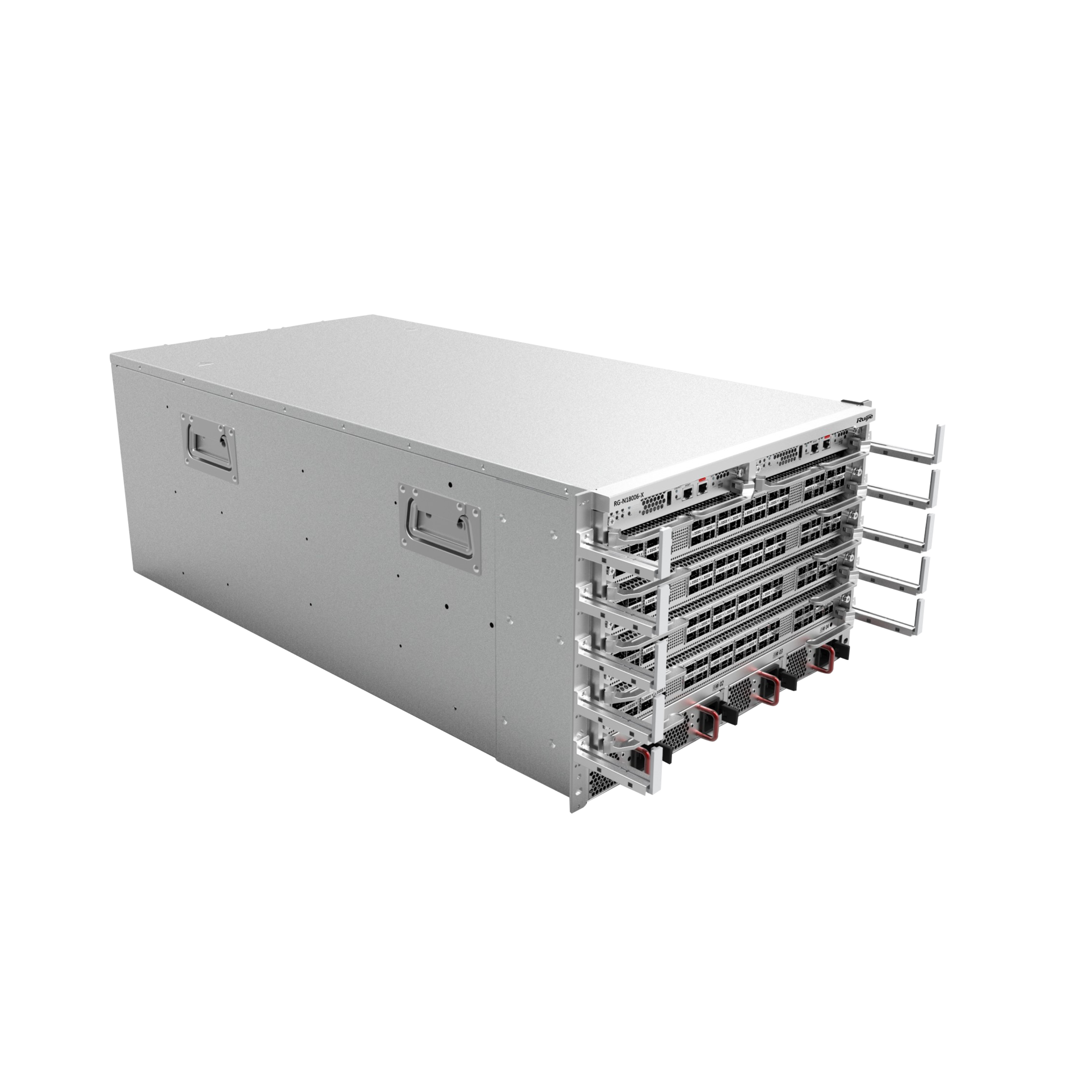four line card slots, 7 RU
Condition: NOB
RMA Warranty
Description
Fit for the core or aggregation node of a legacy data center or core node of a cloud data center, enabling smooth evolution to 400GE in future
- Diverse port types and flexible access capability with 200GE, 100GE, 40GE, and 10GE line cards
- Cross-device link aggregation (de-stacking/M-LAG/VSU), implementing device-level redundancy, flexible networking, and high reliability
- Hardware-level reliability, ensuring service continuity and network stability
- VXLAN tunneling technology, achieving unlimited data transmission and flexible resource allocation and scheduling
- Midplane-free design, improving data transmission efficiency
- Telemetry/gRPC/sFlow/SPAN-based network monitoring and automated O&M, making management simple and efficient
Hardware Specifications
| Hardware Specifications | RG-N18006-X | |
| Module slots | 6 (2 for supervisor modules) | |
| Switch fabric module slots | 6 | |
| Fan module | Three fan module slots | |
| Power module | Four power module slots | |
| Switching capacity | 28.8 Tbps | |
| Packet forwarding rate | 17,280 Mpps | |
| Large buffer | Ultralarge distributed buffer design and 200 ms buffer for each port to prevent packet loss in burst traffic | |
| Dimensions (W × D × H) |
442 mm x 956 mm x 308.4 mm, 7 RU | |
| Weight | 49 kg (including the fan) | |
| Power supply | RG-PA3000I-F:
AC: 90 VAC to 290 VAC HVDC: 192 VDC to 288 VDC |
|
| Ventilation type | Front-to-rear ventilation | |
| Maximum Power Consumption | 19000 W | |
| MTBF | ≤ 200,000 hours | |
| Operating temperature | 0ºC to 40ºC (32ºF to 104ºF) | |
| Storage temperature | –40ºC to +70ºC (–40ºF to +158ºF) | |
| Operating humidity | 10% to 90% RH (non-condensing) | |
| Storage humidity | 5% to 95% RH (non-condensing) | |
| Working altitude | –500 m to 5000 m above the ground | |
Software Specifications
| Software Specifications | RG-N18006-X |
| Device virtualization | Virtual Switching Unit 3.0 |
| Data center features | VXLAN bridge
VXLAN gateway BGP-EVPN VXLAN VXLAN mapping IPv6 VXLAN over IPv4 M-LAG |
| SDN | OpenFlow 1.3. |
| Traffic analysis | sFLOW
IPFIX NetFlow |
| L2 features | Jumbo frame
IEEE 802.3ad (static link aggregation, LACP, cross-card link aggregation, cross-device link aggregation) IEEE 802.1Q STP, RSTP, MSTP GVRP QinQ LLDP Static MAC addresses, address filtering, and limit on the number of MAC addresses |
| IPv4 features | Static routing, RIP, OSPF, IS-IS, and BGP4
VRRP ECMP Policy-based routing |
| IPv6 features | Static routing, OSPFv3, BGP4+, IS-ISv6, and MLDv1/v2
VRRPv3 ECMP Policy-based routing Pingv6, Telnetv6, FTPv6, TFTPv6, DNSv6, ICMPv6 |
| Multicast | IGMP v1/v2/v3
IGMP Snooping IGMP Proxy MLDv1, MLDv2 Multicast static routing Fast leave |
| ACL | Standard, extended, and expert-level ACLs
Global ACLs Ingress/Egress ACLs IPv6 ACLs |
| QoS | Mapping of IEEE 802.1p, DSCP, and ToS priorities Priority marking/remarking Multiple queue scheduling mechanisms, including SP, WRR, DRR, SP+WRR, and SP+DRR Congestion avoidance mechanisms such as RED and WREDPort-based rate limit |
| Reliability | Independent switch fabric modules and independent supervisor engines to implement thorough separation of the forwarding plane from the control plane
1+1 redundancy for supervisor modules N+1 redundancy for switch fabric modules N+M redundancy for power supply modules and fan modules Midplane-free design to avoid single point of failures Hot swapping of components Hot patching BPDU guard/Loop guard/Root guard ISSU NSR DLDP FRR Micro-segmentation security isolation GR for OSPF/IS-IS/BGP BFD for VRRP/OSPF/BGP4/ISIS/ISISv6/static routing |
| Security | Network Foundation Protection Policy (NFPP) and CPU protection policy (CPP) to prevent protocol packet attacks
Prevention against DDoS, ARP, and ICMP attacks DAI, port security, IP source guard, and protected ports uRPF RADIUS and TACACS user login authentication, password security, hierarchical user management, and password protection Source IP address restriction Function of not sending unknown multicast packets to the CPU Suppression of unknown multicast, unknown broadcast, and unknown multicast packets SSHv2, providing encrypted security channels for user login ITU-T Y.1731 Prevention against MAC address flapping Plaintext and MD5 ciphertext authentication for OSPF, RIPv2, and BGP4 packets |
| Management | Console/AUX Modem/Telnet/SSH2.0 CLI configuration
FTP, TFTP, Xmodem, and SFTP SNMP V1/V2c/V3 NETCONF RMON NTP clock Fault alarm and auto-recovery System operation logging Traffic analysis Zero-touch provisioning (ZTP) Reliable network service (RNS), which probes specific services provided by the peer device to monitor the service availability Telemetry Buffer status monitoring and traffic microburst identification Port mirroring, traffic mirroring, and ERSPAN Physical ports on all line cards support the routing mode and IP addresses can be configured independently. Monitoring of fan modules and power supply modules |
Safety and Regulatory Compliance
| Specification | RG-N18006-X |
| Safety | ● EN 62368-1
● IEC 62368-1 ● NM EN 62368-1 ● NM CEI 62368-1 ● UL 62368-1 ● CSA C22.2#62368-1 ● GB 4943.1 |
| Electromagnetic Compatibility (EMC) | ● EN 55032
● EN IEC 61000-3-2 ● NM EN CEI 61000-3-2 ● EN 61000-3-3 ● NM EN 61000-3-3 ● EN 55035 ● NM EN 55035 ● ETSI EN 300 386 ● FCC CFR Title 47, Part 15, Subpart B ● ANSI C63.4-2014 ● ICES-003 Issue 7 ● GB/T 9254.1 |
| Environment | ● 2011/65/EU EN 50581
● 2012/19/EU EN 50419 ● (EC) No.1907/2006 ● GB/T 26572 |







Lucas (verified owner) –
The product is firmly packed.